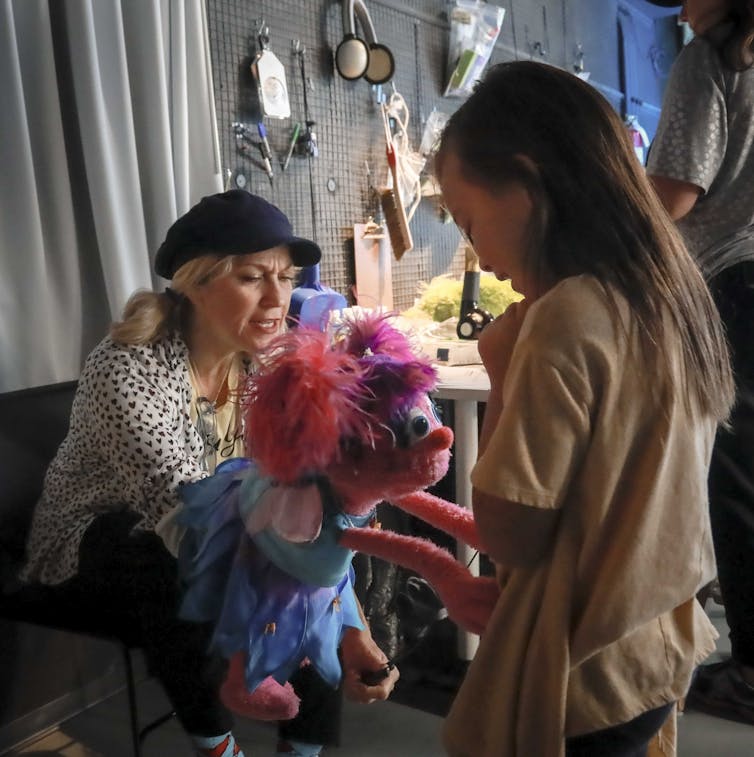U.S. Air Force photo by Staff Sgt. Scott Saldukas/Released via Flickr
Drew Cingel, University of California, Davis; Allyson Snyder, University of California, Davis; Jane Shawcroft, University of California, Davis, and Samantha Vigil, University of California, Davis
To adult viewers, educational media content for children, such as “Sesame Street” or “Daniel Tiger’s Neighborhood,” may seem rather simplistic. The pacing is slow, key themes are often repeated and the visual aspects tend to be plain.
However, many people might be surprised to learn about the sheer amount of research that goes into the design choices many contemporary programs use.
For more than a decade, I have studied just that: how to design media to support children’s learning, particularly in moral development. My research, along with the work of many others, shows that children can learn important developmental and social skills through media.
History of research on children’s media
Research on how to design children’s media to support learning is not new.
When “Sesame Street” debuted in November 1969, it began a decadeslong practice of testing its content before airing it to ensure children learned the intended messages of each episode and enjoyed watching it. Some episodes included messages notoriously difficult to teach to young children, including lessons about death, divorce and racism.
Researchers at the Sesame Workshop hold focus groups at local preschools where participating children watch or interact with Sesame content. They test the children on whether they are engaged with, pay attention to and learn the intended message of the content. If the episode passes the test, then it moves on to the next stage of production.

AP Photo/Bebeto Matthews
If children do not learn the intended message, or are not engaged and attentive, then the episode goes back for editing. In some cases, such as a 1992 program designed to teach children about divorce, the entire episode is scrapped. In this case, children misunderstood some key information about divorce. “Sesame Street” did not include divorce in its content until 2012.
Designing children’s media
With help from the pioneering research of “Sesame Street,” along with research from other children’s television shows both in the industry and in academia, the past few decades have seen many new insights on how best to design media to promote children’s learning. These strategies are still shaping children’s shows today.
For example, you may have noticed that some children’s television characters speak directly to the camera and pause for the child viewer at home to yell out an answer to their question. This design strategy, known as participatory cues, is famously used by the shows “Blue’s Clues” and “Dora the Explorer.” Researchers found that participatory cues in TV are linked to increased vocabulary learning and content comprehension among young children. They also increase children’s engagement with the educational content of the show over time, particularly as they learn the intended lesson and can give the character the correct answer.
You may have also noticed that children’s media often features jokes that seem to be aimed more at adults. These are often commentary about popular culture that require context children might not be aware of or involve more complex language that children might not understand. This is because children are more likely to learn when a supportive adult or older sibling is watching the show alongside them and helping explain or connect it to the child’s life. Known as active mediation, research has shown that talking about the goals, emotions and behaviors of media characters can help children learn from them and even improve aspects of their own emotional and social development.
Programs have also incorporated concrete examples of desired behaviors, such as treating a neurodiverse character fairly, rather than discussing the behaviors more abstractly. This is because children younger than about age 7 struggle with abstract thinking and may have difficulty generalizing content they learned from media and applying it to their own lives.
Research on an episode of “Arthur” found that a concrete example of a main character experiencing life through the eyes of another character with Asperger’s syndrome improved the ability of child viewers to take another person’s perspective. It also increased the nuance of their moral judgments and moral reasoning. Just a single viewing of that one episode can positively influence several aspects of a child’s cognitive and moral development.
Teaching inclusion through media
One skill that has proven difficult to teach children through media is inclusivity. Multiple studies have shown that children are more likely to exclude others from their social group after viewing an episode explicitly designed to promote inclusion.
For example, an episode of “Clifford the Big Red Dog” involved Clifford and his family moving to a new town. The townspeople initially did not want to include Clifford because he was too big, but they eventually learned the importance of getting to know others before making judgments about them. However, watching this episode did not make children more likely to play with or view disabled or overweight children favorably.
Based on my own work, I argue that one reason inclusivity can be difficult to teach in children’s TV may be due to how narratives are structured. For example, many shows actually model antisocial behaviors during the first three-quarters of the episode before finally modeling prosocial behaviors at the end. This may inadvertently teach the wrong message, because children tend to focus on the behaviors modeled for the majority of the program.
My team and I conducted a recent study showing that including a 30-second clip prior to the episode that explains the inclusive message to children before they view the content can help increase prosocial behaviors and decrease stigmatization. Although this practice might not be common in children’s TV at the moment, adult viewers can also fill this role by explaining the intended message of inclusivity to children before watching the episode.

miniseries/E+ via Getty Images
Parenting with media
Children’s media is more complex than many people think. Although there is certainly a lot of media out there that may not use study-informed design practices, many shows do use research to ensure children have the best chance to learn from what they watch.
It can be difficult to be a parent or a child in a media-saturated world, particularly in deciding when children should begin to watch media and which media they should watch. But there are relatively simple strategies parents and supportive adults can use to leverage media to support their child’s healthy development and future.
Parents and other adults can help children learn from media by watching alongside them and answering their questions. They can also read reviews of media to determine its quality and age appropriateness. Doing so can help children consume media in a healthy way.
We live in a media-saturated world, and restricting young children’s media use is difficult for most families. With just a little effort, parents can model healthy ways to use media for their children and select research-informed media that promotes healthy development and well-being among the next generation.![]()
Drew Cingel, Associate Professor of Communication, University of California, Davis; Allyson Snyder, Ph.D. Candidate in Communication, University of California, Davis; Jane Shawcroft, Ph.D. Candidate in Communication, University of California, Davis, and Samantha Vigil, Ph.D. Candidate in Communication, University of California, Davis
This article is republished from The Conversation under a Creative Commons license. Read the original article.


Recent Comments